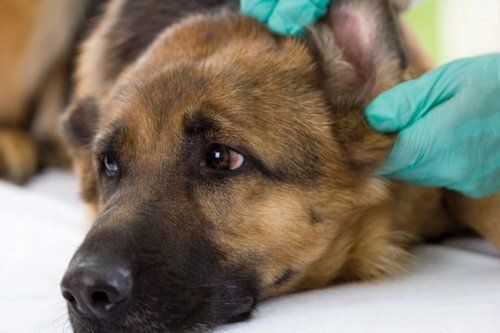Dermatomyositis in Dogs
Dermatomyositis in dogs is an inherited disease that causes inflammation of the skin, muscles, and blood vessels. The disease primarily occurs only in certain breeds, but can develop in any type of dog. Symptoms vary in severity, and can usually be managed in mild to moderate cases.
Signs and Symptoms of Canine Dermatomyositis
Symptoms usually appear by the time the puppy is six months old, but they might be seen as early as seven weeks of age. Though rare, adult-onset dermatomyositis can occur. Signs of the condition vary in severity but commonly include the following:
- Lesions that result in hair loss
- Foot-pad ulcers
- Crusty lesions
- Ulcerated lesions
- Lesions in the mouth or on the face, ears, tip of the tail, or pressure points
- Decrease in muscle mass, known as muscle atrophy, especially in the face and around the jaw
- Weakness
- A stiff gait, if the muscles are inflamed or ulcers are on the feet
- Enlarged esophagus, which is the tube that goes from the throat to the stomach, which can lead to regurgitation and weight loss
Dogs more severely affected might have difficulty eating, drinking, and swallowing. Scarring from the lesions often occurs. The symptoms may come and go over time.
Causes of Dermatomyositis in Dogs
Causes for dermatomyositis usually are hereditary. Sometimes, dermatomyositis in dogs can be traced to an immune-mediated disease or to infectious agents.
What Breeds Are Affected by Dermatomyositis?
Though any dog might suffer from dermatomyositis, some breeds are more likely to be affected. Dermatomyositis in dogs primarily is isolated to collies, Shetland sheepdogs, and their cross-breeds. Breeds that have reported similar symptoms include chow chows, Lakeland terriers, German shepherds, Welsh corgis, Beaucerons, and Kuvasz.
How Canine Dermatomyositis Is Diagnosed
Dermatomyositis is usually diagnosed based on clinical signs and a biopsy of skin and/or muscle. Occasionally, a vet will use specialized testing of EMG, or electrical muscle function.
Treatment and Care for a Dog With Dermatomyositis
Canine dermatomyositis cannot be cured, but its symptoms can be managed. General recommendations include:
- Protect the dog’s skin from further irritation and damage by avoiding activities that traumatize the skin and by minimizing ultraviolet exposure. Exposure to intense sunlight worsens skin lesions, so a dog with dermatomyositis should stay indoors during daylight.
- Hypoallergenic shampoos and other treatments might be used for secondary bacterial skin infections.
- In mild cases, the dog’s daily diet can be supplemented with fatty acids and vitamin E.
- In moderate to severe cases, the veterinarian might prescribe steroids to decrease inflammation and/or medicine to improve blood flow.
If the dog with dermatomyositis is diagnosed with an enlarged esophagus, the dog is at an increased risk for pneumonia, so care should be taken to avoid conditions that can lead to pneumonia. The dog also might have difficulty eating or swallowing because of an enlarged esophagus, lesions in the mouth, or muscle atrophy or weakness around the jaw. Depending on the severity of the difficulties, the dog might require a change in diet, assistance eating, or supportive care. If a dog’s chewing muscles are affected, hand feeding or formation of food into softened balls might be necessary.
Dogs with dermatomyositis should not breed, and they should be neutered to prevent passing along the disease.
Prognosis for Dogs Infected With Dermatomyositis
The outlook for dogs with dermatomyositis is highly variable, with the condition sometimes resolving spontaneously on its own. For others, they might be afflicted with life-long inflammation and muscle atrophy. Only time and treatment will show how an individual dog will fare.
Other Skin Issues in Dogs
Related Content



















